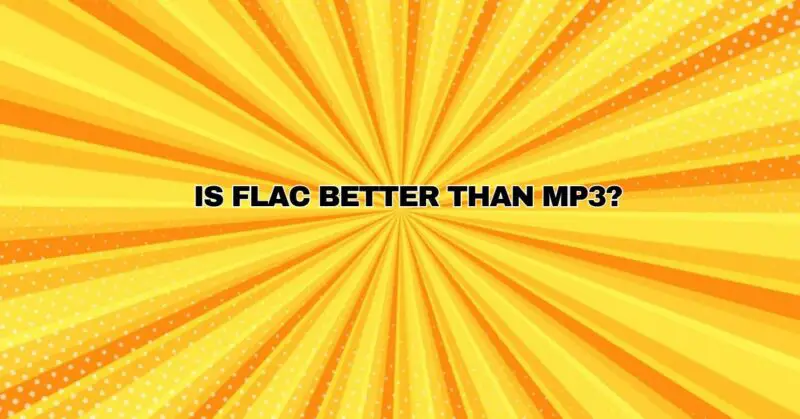The ongoing debate between FLAC (Free Lossless Audio Codec) and MP3 (MPEG Audio Layer-3) has been a central discussion point among audiophiles and music enthusiasts for years. These two audio formats represent different approaches to audio compression, each with its set of advantages and disadvantages. In this comprehensive article, we will delve into the FLAC vs. MP3 debate, exploring the technical differences between the two formats, their respective strengths and weaknesses, and considerations for choosing the right format for your listening preferences.
Understanding FLAC and MP3:
Before we compare FLAC and MP3, let’s understand the basics of these two audio formats:
- FLAC (Free Lossless Audio Codec): FLAC is a lossless audio compression format that preserves the original audio quality while reducing file size. It achieves compression by eliminating redundant data, making it an excellent choice for audiophiles who prioritize audio fidelity.
- MP3 (MPEG Audio Layer-3): MP3 is a lossy audio compression format designed to reduce file sizes significantly while delivering acceptable audio quality. MP3 achieves compression by discarding certain audio data that is deemed less audible to most listeners.
FLAC vs. MP3: A Detailed Comparison:
Now, let’s explore the key differences and attributes of FLAC and MP3:
1. Audio Quality:
- FLAC: FLAC is a lossless format, meaning it preserves all the audio data from the original source. This results in uncompromised audio quality, making it virtually indistinguishable from the original source material.
- MP3: MP3 is a lossy format, which means it sacrifices some audio data to achieve compression. While MP3 can provide good audio quality, the extent of loss depends on the bit rate chosen during encoding. Higher bit rates result in better quality but larger file sizes.
2. File Size:
- FLAC: FLAC files are significantly larger than MP3 files, typically about 50-70% of the original uncompressed audio file size. This makes FLAC less suitable for devices with limited storage capacity.
- MP3: MP3 files are much smaller than FLAC files due to the lossy compression. The file size depends on the chosen bit rate, with lower bit rates producing smaller files but potentially lower audio quality.
3. Compatibility:
- FLAC: FLAC files are less universally supported than MP3 files. While many media players and devices now support FLAC, some older or less common hardware and software may not be compatible.
- MP3: MP3 is one of the most widely supported audio formats. Virtually all media players, smartphones, and portable devices can play MP3 files without issues.
4. Bit Rate Flexibility:
- FLAC: FLAC does not offer variable bit rates. It uses a constant bit rate, resulting in consistently high audio quality but larger file sizes.
- MP3: MP3 supports variable bit rates (VBR), allowing for more efficient compression. This means that MP3 files can adapt their bit rate to the complexity of the audio content, resulting in smaller file sizes without significant quality loss.
5. Use Cases:
- FLAC: FLAC is preferred for archival purposes and by audiophiles who prioritize audio quality above all else. It is an excellent choice for preserving the highest possible fidelity of music recordings.
- MP3: MP3 is widely used for portable audio devices, streaming, and online distribution due to its smaller file sizes. It strikes a balance between acceptable audio quality and storage efficiency.
6. Lossy vs. Lossless:
- FLAC: FLAC is a lossless format, meaning it retains all audio data from the original source. No audio quality is sacrificed during compression.
- MP3: MP3 is a lossy format, which means it discards some audio data to achieve compression. The degree of loss depends on the chosen bit rate.
7. Bit Depth and Sample Rate:
- FLAC: FLAC supports a wide range of bit depths and sample rates, making it suitable for high-resolution audio.
- MP3: MP3 is more limited in terms of supported bit depths and sample rates, typically used for CD-quality audio.
Conclusion: Choosing the Right Format
The choice between FLAC and MP3 ultimately depends on your specific needs and priorities:
- If you prioritize the highest possible audio quality and have ample storage space, FLAC is the superior choice.
- If you require smaller file sizes for portable devices or streaming and are willing to accept some degree of audio quality compromise, MP3 is a practical choice.
Ultimately, the FLAC vs. MP3 debate is not about one format being definitively better than the other; it’s about choosing the format that best aligns with your preferences, priorities, and the intended use of the audio files. Both formats have their merits, and their suitability varies depending on the context and your specific listening requirements.


